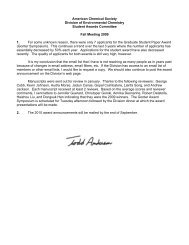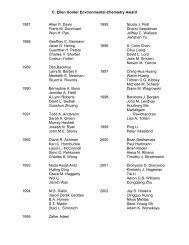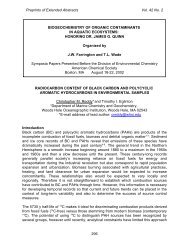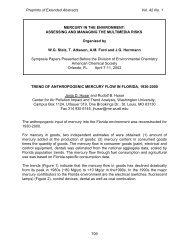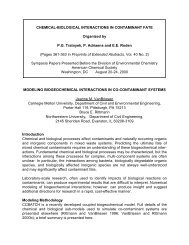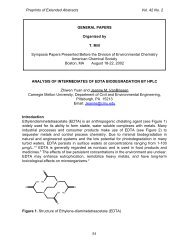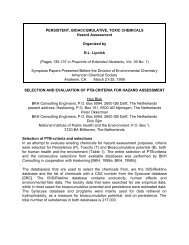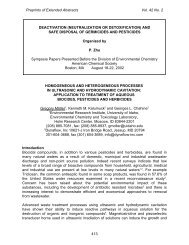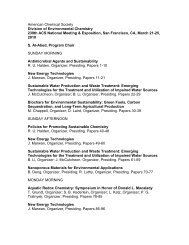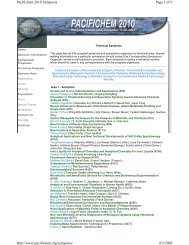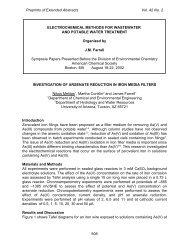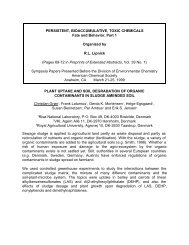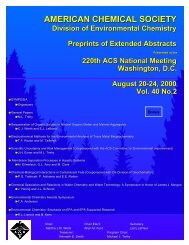139 - ACS: Division of Environmental Chemistry
139 - ACS: Division of Environmental Chemistry
139 - ACS: Division of Environmental Chemistry
You also want an ePaper? Increase the reach of your titles
YUMPU automatically turns print PDFs into web optimized ePapers that Google loves.
GENERAL PAPERS<br />
Air Session<br />
Organized by<br />
A.M. Ford<br />
(Pages 3-4 in Preprints <strong>of</strong> Extended Abstracts, Vol. 39 No. 1)<br />
Symposia Papers Presented Before the <strong>Division</strong> <strong>of</strong> <strong>Environmental</strong> <strong>Chemistry</strong><br />
American Chemical Society<br />
Anaheim, CA March 21-25, 1999<br />
MULTIPHASE NITRATION OF PHENOL IN TROPOSPHERE<br />
B. Rindone 3 , E. Bolzacchini 3 , Th. Umschlag 1 , H. Herrmann 2 and S. Meinardi 3<br />
1 Institut, für Physikalische und Theoretische Chemie, Universität GH Essen,<br />
Universitässtr. 5, D-45117 Essen, Germany<br />
Phone: +49-(0)201-183 3205, Fax: +49-(0)201-183 3228,<br />
E-mail: thomas.umschlag@uni-essen.de<br />
2 Institut für Troposphärenforschung, Permoserstr. 15, D-04303 Leipzig, Germany<br />
E-mail: h.herrmann@tropos.de.<br />
3 <strong>Environmental</strong> Science Department, University <strong>of</strong> Milano, Via L. Emanueli, 15,<br />
1-20126 Milano, Italy<br />
Phone: +39-(0)2-64474303, Fax: +39-(0)2-64474300, E-mail: ezio.bolzacchini@unimi.it<br />
Emissions <strong>of</strong> benzene and toluene from traffic or industry 1 result in the formation <strong>of</strong><br />
phenol or cresols and ring fragmentation products 2 . Phenols are known to be formed in<br />
the atmosphere by the OH-initiated atmospheric oxidation <strong>of</strong> aromatic hydrocarbons<br />
and a number <strong>of</strong> product studies reported in the literature show that their yields can be<br />
relatively high (e.g. as high as 19% in the case <strong>of</strong> p-xylene , subsequent to the uptake<br />
by cloud droplets 2 .<br />
Phenolic material is then transformed into nitrophenols 3 . In fact, nitrophenols have<br />
been found in rainwater in the µg L -1 range in the Rhein-Ruhr area in western<br />
Germany 4 and in urban Los Angeles rain 5 . Dinitrophenols are suggested to constitute<br />
particulate matter.<br />
The phytotoxicity <strong>of</strong> nitro- and dinitrophenols is well documented 6 and strongly depends<br />
on the position <strong>of</strong> the nitro group(s) relative to the phenolic moiety 7 .<br />
Aromatic nitroderivatives may either be directly emitted from anthropogenic sources,<br />
they may be formed by tropospheric, gas phase reactions and finally they may be<br />
formed within the tropospheric aqueous phase. These processes may be driven by
eactions <strong>of</strong> the nitrate radical with dissolved aromatics or by the reaction <strong>of</strong> the<br />
nitronium cation (NO2 + ) formed from the dissociation <strong>of</strong> its gas phase precursor N2O5 on<br />
aqueous surfaces within the troposphere.<br />
Reaction products are shown in Scheme 1. The quantitative analysis <strong>of</strong> the reaction<br />
products is reported in Table 1.<br />
Scheme 1<br />
Table 1<br />
NO2/O3 CH3CN 87 2:45.4; 3:36.1; 4:2.5;<br />
5:1.6; 6:1.4<br />
1.22<br />
CAN/hv CH3CN 100<br />
2:41; 3: 49; 6:9<br />
0.85<br />
d<br />
NO2/O3 CH3NO2 24<br />
2:12.4; 3:11<br />
1.08<br />
d<br />
NO2/O3 THF<br />
97<br />
2:37.6; 3:57.4; 6:2<br />
0.85<br />
d<br />
CH2Cl2 58<br />
2:26.5; 3: 28.5; 6:3<br />
0.82<br />
e<br />
NO2/O3 d<br />
NO2/O3 CHCl3 72 2:33; 3:30; 4:5.3; 6:3.7 0.72<br />
d<br />
HNO3/H2SO4 H2O<br />
98 2:28.1; 3:57.5; 6: 6.4 0.47<br />
c<br />
HNO3 65% H2O<br />
65<br />
2:26.5; 3:32.5; 6: 6<br />
0.82<br />
b<br />
isomer ratio<br />
ortho:para (%) a<br />
reagent solvent Conversion Reaction products<br />
(%)<br />
aNo m-nitro phenol was detected.<br />
b,cReactions were carried out at a temperature between 0 and 4ºC.<br />
dAll reactions were carried out for the substrate (1 mmol) in solvent (30 mL) containing<br />
nitrogen dioxide and ozone at 0ºC.<br />
eMilder condition due to the high reactivity in this solvent.<br />
Phenol 1 is converted into a mixture <strong>of</strong> mono- and poly-nitrophenols; in very high yields<br />
by the conventional electrophilic nitration reaction where NO2 + is the reagent 8 . Scheme<br />
1 reports the reaction products obtained. Under these conditions, para-nitrophenol 3 is<br />
slightly preferred to orthonitrophenol 2 (Ortho/para ratio 0.72-0.79). 2,4- 4,<br />
2,6-dinitrophenol 5 and p-benzoquinone 6 are also formed.<br />
The nitration via the kyodai method 9 generates NO3 in liquid phase via the reaction <strong>of</strong><br />
ozone with nitrogen dioxide. The reactions were carried out in different solvent at 0ºC<br />
and stopped after 1 minute in order to obtain essentially the mono-nitration products.
Different results were obtained using a different source <strong>of</strong> the nitrate radical in liquid<br />
phase, e. g. the photolysis <strong>of</strong> cerium(IV) ammonium nitrate (CAN) under a nitrogen<br />
atmosphere. Using acetonitrile as the solvent a ortho to para ratio 0.85 was obtained.<br />
This ratio was slightly lower than that obtained with the kyodai system in the same<br />
solvent. A much lower conversion was obtained in water, and the ortho nitration<br />
product was sharply preferred to the para isomer.<br />
Kinetic studies on the aqueous radical nitration <strong>of</strong> phenol were carried by generating<br />
NO3• radicals via photolysis at pH 0 <strong>of</strong> peroxodisulphate solutions containing nitrate<br />
anions (NO3 - ) using an excimer laser at λ = 248 nm (active medium: KrF). All<br />
experiments are carried out under pseudo-first order conditions. The rate constants<br />
shown in Table 2 were obtained. A study <strong>of</strong> temperature dependence <strong>of</strong> the rate<br />
constant <strong>of</strong> the reaction <strong>of</strong> phenol with NO3 in the T-range <strong>of</strong> 288 K < T < 328 K gave<br />
the results shown in Table 2.<br />
As can be seen from the derived rate constants the reaction <strong>of</strong> the NO3. radical with<br />
phenol and its nitration products proceeds very fast. So these reactions might be <strong>of</strong><br />
importance for troposheric cloud and aerosol chemistry. At daytime the degradation <strong>of</strong><br />
the aromatics compounds may predominantly expire via the reaction <strong>of</strong> OH radicals<br />
with them. At night, however the reaction <strong>of</strong> the NO3 • radical with these compounds<br />
might be an additional pathway in the nitration <strong>of</strong> aromatic compounds in aqueous<br />
solution beside the nitration <strong>of</strong> aromatics by the nitronium cation (NO2 + ).<br />
compound<br />
Phenol, 1<br />
4-nitrophenol, 3<br />
2,4-dinitrophenol, 4<br />
(1.8 ± 0.3) x 109 k2nd / L mol-1 s-1 (5.3 ± 0.6) x 108 (7.1 ± 0.4) x 108 Table 2<br />
k(T)<br />
(1.4 ± 0.2) exp [-<br />
(2050 ± 480)K/T<br />
Activation parameters<br />
ΔH ! = 14.5 ± 3.4 kJ mol -1<br />
ΔS ! = -20.7 ± 3.0 J mol -1 K -1<br />
ΔG ! = 20.7 ± 7.8 kJ mol -1<br />
Ea = 17 ± 4 kJ mol -1<br />
Acknowlegments<br />
Support <strong>of</strong> this study under EC-contract ENV4-CT97-0411 (Project UNARO) is<br />
gratefully acknowledged.<br />
References<br />
1. Piccot, S.D., Watson, J.J., Jones, J.W. J. Geophys. Res., 1992, 97D, 9897-9912;<br />
Finlayson-Pitts, B.J., Pitts, Jr J.N. Atmospheric <strong>Chemistry</strong>: Fundamentals and<br />
Experimental Teeniques, Wiley, New York., 1988.<br />
2. Atkinson, R.J. Phys. Chem. Ref. Data, Monograph 2, 1991, 20, 459-507.<br />
3. Bolzacchini, E. , Umschlag, Th., Herrmann, H., Meinardi, S., Rindone, B., Kinetic<br />
and Product Study <strong>of</strong> the Reaction <strong>of</strong> the NO3. Radical with Phenol, Benzoic Acid<br />
and their Nitration Products in Aqueous Solution, 6th FECS Conference on<br />
<strong>Chemistry</strong> and the Environment, Copenhagen, Denmark 26-28 August, 1998.
4. Levsen, K., Behnert, S., Priess, B., Svoboda, M., Winkeler, H.D., Zietlow, J., 1990,<br />
Chemosphere, 21, 1037-1061; Mussmann. P., Levsen, K., Radeck, W., Fresenius<br />
Journal <strong>of</strong> Analytical <strong>Chemistry</strong>, 1994, 348,654-659; Geißler, A., Schöler, H. F.,<br />
Vom Wasser, 1993, 80, 357; Geitiler, A., Schöler, H. F., War. Res., 1994, 28, 2047.<br />
5. Kawamura, K., Kaplan, I.R., Organic Compounds in Rainwater, 1991, in Hansen,<br />
L.D., Eatough, D.J., Organic <strong>Chemistry</strong> <strong>of</strong> the Atmosphere, 1991, CRC Press, Boca<br />
Raton, 233.<br />
6. Von Oettingen, W.F., Nitro compounds and related phenolic insecticides in<br />
Handbook <strong>of</strong> Pesticide Toxicology, 1991, Academic Press, New York 1994; Shea,<br />
P.J., Weber, J.B., Overcash, M.R., 1983 Res. Rev., 87, 1; Schafer, W.E.,<br />
Schonherr, Ecotox. Environ. Safe., 1985, 10, 239.<br />
7. Barletta, B., Belloli, R., Botzacchini, E., Meinardi, S., Orlandi, M., Rindone, B., Toxic<br />
nitrophenols from the liquid phase nitration <strong>of</strong> phenols Eurotrac-2 Symposium,<br />
Garmisch 23-27 march 1998.<br />
8. Olah, G.A., Malhotra, R., Narang S.C. Nitration: Methods and Mechanism, 1989,<br />
VCH Publishers Inc., New York, p 201-204.<br />
9. Suzuki, H., Nonoyama, N., Tomaru, J., Mori, T., 1996, Zh. Org. Khim. 32, 265-268;<br />
Suzuki, H., Nonoyama, N., 1997, J. Chem. Soc. Perkin Trans. 1, 2965-2971;<br />
Suzuki, H., Mori, T., 1997, J. Org.Chem, 62, 6498-6502.



